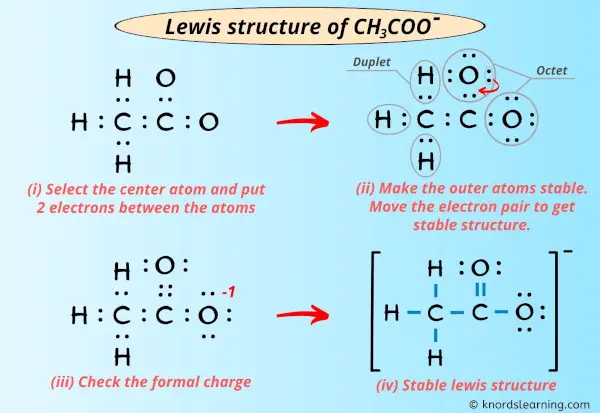
I’m super excited to teach you the lewis structure of CH3COO- ion in just 6 simple steps.
Infact, I’ve also given the step-by-step images for drawing the lewis dot structure of CH3COO- ion.
So, if you are ready to go with these 6 simple steps, then let’s dive right into it!
Lewis structure of CH3COO- ion (or Acetate ion) contains two Carbon atoms (C) at the center and they are surrounded by three Hydrogen atoms (H) and two Oxygen atoms (O). One Oxygen is single bonded while the other Oxygen is double bonded with the Carbon. The single bonded Oxygen atom has 3 lone pairs and the double bonded Oxygen has 2 lone pairs. The single bonded Oxygen atom has -1 formal charge.
Let’s draw and understand this lewis dot structure step by step.
(Note: Take a pen and paper with you and try to draw this lewis structure along with me. I am sure you will definitely learn how to draw lewis structure of CH3COO- ion).
6 Steps to Draw the Lewis Structure of CH3COO- ion
Step #1: Calculate the total number of valence electrons
Here, the given molecule is CH3COO- ion (acetate acid). In order to draw the lewis structure of CH3COO- ion, first of all you have to find the total number of valence electrons present in the CH3COO- ion.
(Valence electrons are the number of electrons present in the outermost shell of an atom).
So, let’s calculate this first.
Calculation of valence electrons in CH3COO- ion
- For Carbon:

Carbon is a group 14 element on the periodic table. [1]
Hence, the valence electrons present in carbon is 4 (see below image).

- For Hydrogen:

Hydrogen is a group 1 element on the periodic table. [2]
Hence, the valence electron present in hydrogen is 1 (see below image).

- For Oxygen:

Oxygen is a group 16 element on the periodic table. [3]
Hence, the valence electron present in oxygen is 6 (see below image).

Hence in a CH3COO- ion,
Valence electrons given by each Carbon (C) atom = 4
Valence electron given by each Hydrogen (H) atom = 1
Valence electrons given by each Oxygen (O) atom = 6
Electron due to -1 charge, 1 more electron is added
So, total number of Valence electrons in CH3COO- ion = 4 + 1(3) + 4 + 6 + 6 + 1 = 24
Step #2: Select the center atom (H is always outside)
While selecting the center atom, always put the least electronegative atom at the center.

(Remember: Fluorine is the most electronegative element on the periodic table and the electronegativity decreases as we move right to left in the periodic table as well as top to bottom in the periodic table). [4]
Here in the CH3COO- ion, if we compare the carbon atom (C), oxygen atom (O) and hydrogen atom (H), then hydrogen is less electronegative than oxygen and carbon. But as per the rule, we have to keep hydrogen outside.
So, carbon (which is less electronegative than oxygen) should be placed in the center and the remaining hydrogen atoms as well as oxygen atoms will surround it.

Step #3: Put two electrons between the atoms to represent a chemical bond
Now in the above sketch of CH3COO molecule, put the two electrons (i.e electron pair) between the carbon atom, oxygen atom and hydrogen atom to represent a chemical bond between them.

These pairs of electrons present between the Carbon (C), Oxygen (O) and Hydrogen (H) atoms form a chemical bond, which bonds these atoms with each other in a CH3COO molecule.
Step #4: Complete the octet (or duplet) on outside atoms
Don’t worry, I’ll explain!
In the Lewis structure of CH3COO, the outer atoms are hydrogen atoms as well as oxygen atom.
Hydrogen already has a duplet (see below image).
So now, you have to complete the octet on oxygen atom (because oxygen requires 8 electrons to have a complete outer shell).
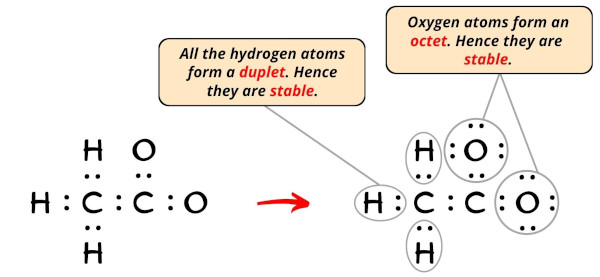
Now, you can see in the above image that the oxygen atom forms an octet.
Also, all the 24 valence electrons of CH3COO- ion (as calculated in step #1) are used in the above structure. So there are no remaining electron pairs.
Hence there is no change in the above sketch of CH3COO.
Let’s move to the next step.
Step #5: Check whether the central atom has octet or not. If it does not have an octet, then move the electron pair from the outer atom to form a double bond or triple bond
In this step, we have to check whether the central atom (i.e carbon) has an octet or not.
In simple words, we have to check whether the central Carbon (C) atom has 8 electrons or not.
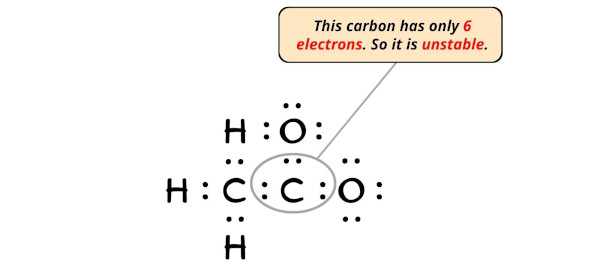
As you can see from the above image, the central atom (i.e carbon) has only 6 electrons. So it does not fulfill the octet rule.
Now, in order to fulfill the octet of carbon atom, we have to move the electron pair from the outer atom (i.e oxygen atom) to form a double bond.
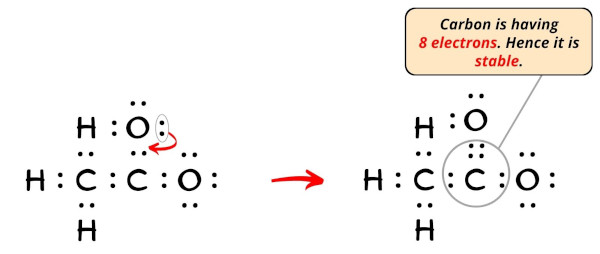
Now you can see from the above image that the carbon atom is having 8 electrons. So it fulfills the octet rule.
Step #6: Final step – Check the stability of lewis structure by calculating the formal charge on each atom
Now, you have come to the final step and here you have to check the formal charge on carbon atom (C), oxygen atom (O) as well as each hydrogen atom (H).
For that, you need to remember the formula of formal charge;
Formal charge = Valence electrons – Nonbonding electrons – (Bonding electrons)/2
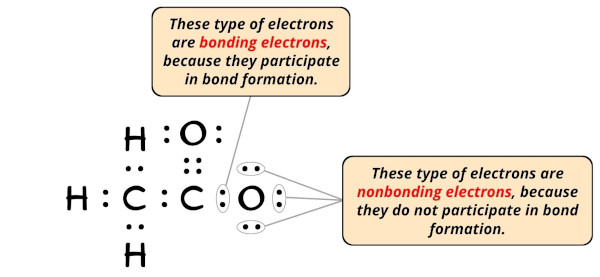
- For Carbon:
Valence electrons = 4 (as it is in group 14)
Nonbonding electrons = 0
Bonding electrons = 8 - For Hydrogen:
Valence electron = 1 (as it is in group 1)
Nonbonding electrons = 0
Bonding electrons = 2 - For single bonded Oxygen:
Valence electron = 6 (as it is in group 16)
Nonbonding electrons = 6
Bonding electrons = 2 - For double bonded Oxygen:
Valence electron = 6 (as it is in group 16)
Nonbonding electrons = 4
Bonding electrons = 4
| Formal charge | = | Valence electrons | – | Nonbonding electrons | – | (Bonding electrons)/2 | ||
| C | = | 4 | – | 0 | – | 8/2 | = | 0 |
| H | = | 1 | – | 0 | – | 2/2 | = | 0 |
| Single bonded O | = | 6 | – | 6 | – | 2/2 | = | -1 |
| Double bonded O | = | 6 | – | 4 | – | 4/2 | = | 0 |
Let’s keep these charges on the atoms in the above lewis structure.

As you can see in the above sketch, there is one -ve charge on the single bonded oxygen atom, which indicates the -1 formal charge on the CH3COO molecule.
Hence, the above lewis structure of CH3COO- ion is the stable lewis structure.
Each electron pair (:) in the lewis dot structure of CH3COO- ion represents the single bond ( | ). So the above lewis dot structure of CH3COO- ion (acetate ion) can also be represented as shown below.

Related lewis structures for your practice:
Lewis Structure of Acetone (C3H6O)
Lewis Structure of POCl3
Lewis Structure of HNO2
Lewis Structure of HCO3-
Lewis Structure of C3H8 (Propane)
Article by;
Jay is an educator and has helped more than 100,000 students in their studies by providing simple and easy explanations on different science-related topics. With a desire to make learning accessible for everyone, he founded Knords Learning, an online learning platform that provides students with easily understandable explanations.
Read more about our Editorial process.
